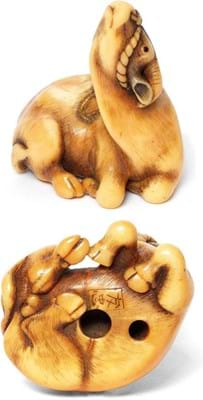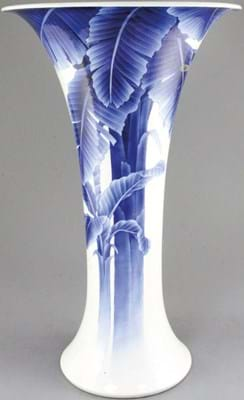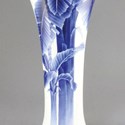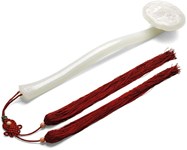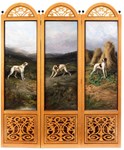The couple made their first purchase in Kyoto while on a concert tour of Japan in 1953, later immersing themselves in the subject with the encouragement of London dealer Geoffrey Moss.
Many important purchases were made across the series of sales of the MT Hindson collection at Sotheby’s in the late 1960s. They included an ivory model of a recumbent ox by the 18th century Kyoto master Tomotada. The compact study, admired in a number of important 20th century collections including that of Isobel Sharpe, is believed to be unique. It sold for £120,000 (estimate £25,000-30,000).
It was at the final Hindson sale in 1969 – sadly two months after Julius Katchen had died – that his widow had purchased, in his memory, a celebrated netsuke of a shaggy dog and pup by the enigmatic late 18th and early 19th century carver Gechu. This was the carving that sold to a solitary bid of £180,000 in the first Katchen sale in November.
Sold in May for £32,000 was a late 18th century ivory netsuke of a seated tiger by Masanao. It is modelled seated, its head lowered to the left as it licks its raised hind paw, its tail and legs drawn in for compactness. It came with a century-long provenance, beginning with its sale as part of the Harry Seymour Trower collection at Glendining in 1913 and its appearance at the Red Cross Exhibition in wartime London in 1915. It was published as part of the Frederick Meinertzhagen collection (The Art of the Netsuke Carver) in 1956.
Also signed by Masanao was a near circular or manju form carving of a crane, its neck bent and its head resting on one spread wing. Formerly part of the Gordon Fox collection, Montreal, it took £52,000.
While a number of netsuke from the Katchen collection have been disposed of over the years, Bonhams are selling the considerable remainder in three parts, the third and final sale is in May 2018.
Meiji masters
Meiji works of art dominated the May 11 sale topped at £49,000 by a gold lacquer four-case inro by Shibata Zeshin (1807-91).
The decoration of two carp swimming in a pond is accompanied by a signature in gold hiramaki-e characters translated as Drawn by Zeshin after a painting by Maruyama Okyo.
Some strong prices emerged for metalwork. A 3in (8cm) baluster cloisonné-enamel vase by Namikawa Yasuyuki (1845-1927) was among the most eagerly contested lots, selling at £35,000 (estimate £4000-6000).
The decoration of a rustic landscape with thatched houses nestled among trees by a winding stream, in shades of green enamel, was a particularly unusual subject.
Gorringes’ sale in Lewes on April 25 included two large porcelain blue and white trumpet-shaped vases from the Kozan studio.
Each standing 2ft (60cm) high, they were catalogued as by Makuzu Kozan II (Miyagawa Hanzan, 1858- 1940) but may well have been by his adopted father and predecessor Makuzu Kozan (1842-1916).
Both were signed to the base Makuzu Kozan sei.
Estimated at £400-600 but sold at £14,000 to a UK specialist dealer was a vessel decorated with palm leaves. This striking vase, similar to another in the Khalili collection, is comparable to one exhibited by Kozan in the Paris Exposition of 1900. Despite two hairline cracks to the rim, another vase of the same period painted with confronting dragons took £4600.
Bonhams’ sale included a Makuzu Kozan vase of similar dimensions from the late 1890s.
A bulbous form moulded with eight acanthus-leaf panels, each enclosing a leaping sinuous scaly dragon painted in underglaze blue, it sold for £17,000.


